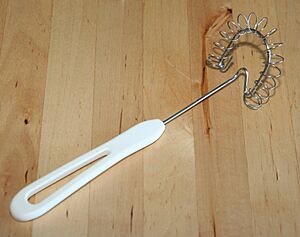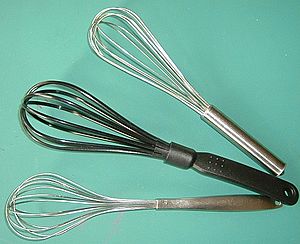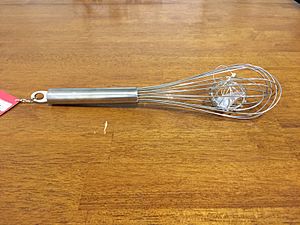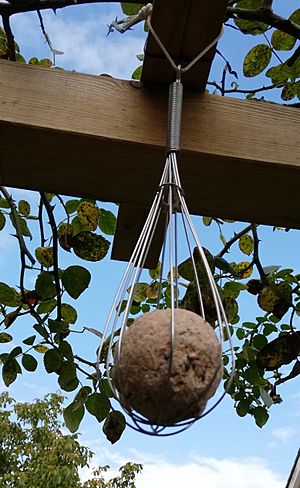Whisk facts for kids

A whisk is a handy cooking utensil. You can use it to mix ingredients until they are smooth. Whisks are also great for adding air into a mixture. This process is called whisking or whipping.
Most whisks have a long handle. At the end, they have many wire loops joined together. These wires are usually made of metal. But some are made of plastic so they can be used with nonstick pans. You can also find whisks made from bamboo.
Whisks are often used to whip egg whites. This makes a firm foam for things like meringue. They are also used to whip cream into whipped cream.
What is a Whisk?
Whisks are kitchen tools that help you mix food. They are designed to blend things smoothly. They can also add air to liquids or soft foods. This makes them light and fluffy. Imagine making whipped cream or fluffy eggs. A whisk is perfect for these jobs.
The wire loops on a whisk come in different shapes. Each shape is best for a different cooking task.
The History of Whisks
For a long time, people used bundles of twigs as whisks. Twigs from trees like apple were common. Sometimes, the wood would even add a special smell to the food. An old recipe from the 1700s suggests using peach twigs. It said they would give a "delicate peach flavor" to a cake.
The wire whisk, which we know today, was invented before 1841. This was a big step forward for cooking tools.
In the United States, mechanical egg beaters became popular in the 1900s. These were cranked by hand. But in 1963, a famous chef named Julia Child helped bring the wire whisk back into style. She showed how useful it was on her TV show.
Different Kinds of Whisks
Whisks come in many shapes and sizes. Each one is designed for a specific job in the kitchen.
- The most common whisk looks like a wide teardrop. This is called a balloon whisk. It is best for mixing in bowls. Its curved shape fits well against the sides of a bowl.
- A French whisk has longer, narrower wire loops. It looks more like a cylinder. This shape is good for mixing in deep, straight-sided pans.
- A flat whisk has its loops arranged in a flat pattern. Some people call it a roux whisk. It is useful for mixing in shallow pans, like skillets. This is where you might make a roux for sauces.
- A gravy whisk often has one main loop with another wire coiled around it. It is also called a spiral whisk. The angle of its head is great for mixing gravy, jelly, and sauces.
- A twirl whisk or coil whisk has a single wire spiraled into a balloon shape. You can keep it still in a bowl and pump the handle up and down. This moves liquids around easily. It is perfect for beating eggs.
- Ball whisks do not have loops. Instead, they have individual wires coming from the handle. Each wire has a metal ball at its tip. These heavy balls can reach into the corners of straight-sided pans. Ball whisks are also easier to clean because they have no crossing wires.
- A cage whisk is a type of balloon whisk. It has a small round cage inside it. This cage holds a metal ball.
See also
 In Spanish: Batidor para niños
In Spanish: Batidor para niños






